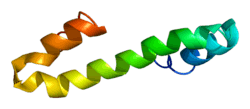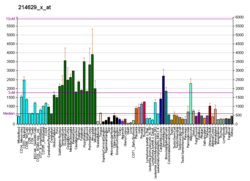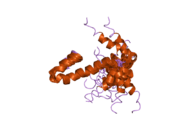Reticulon 4
Reticulon 4, also known as Neurite outgrowth inhibitor or Nogo, is a protein that in humans is encoded by the RTN4 gene[5][6][7] that has been identified as an inhibitor of neurite outgrowth specific to the central nervous system. During neural development Nogo is expressed mainly by neurons and provides an inhibitory signal for the migration and sprouting of CNS endothelial (tip) cells, thereby restricting blood vessel density.
This gene belongs to the family of reticulon-encoding genes. Reticulons are associated with the endoplasmic reticulum, and are involved in neuroendocrine secretion or in membrane trafficking in neuroendocrine cells. The product of this gene is a potent neurite outgrowth inhibitor that may also help block the regeneration of the central nervous system in higher vertebrates. Alternatively spliced transcript variants derived both from differential splicing and differential promoter usage and encoding different isoforms have been identified.[7] There are three isoforms: Nogo A, B and C. Nogo-A has two known inhibitory domains including amino-Nogo, at the N-terminus and Nogo-66, which makes up the molecules extracellular loop. Both amino-Nogo and Nogo-66 are involved in inhibitory responses, where amino-Nogo is a strong inhibitor of neurite outgrowth, and Nogo-66 is involved in growth cone destruction.[8]
Research suggests that blocking Nogo-A during neuronal damage (from diseases such as Multiple Sclerosis) will help to protect or restore the damaged neurons.[8][9] The investigation into the mechanisms of this protein presents a great potential for the treatment of auto-immune mediated demyelinating diseases and spinal cord injury regeneration. It has also been found to be a key player in the process whereby physical exercise enhances learning and memory processes in the brain.[10]
Interactions
Reticulon 4 has been shown to interact with WWP1,[11] BCL2-like 1[12] and Bcl-2.[12]
See also
References
- 1 2 3 GRCh38: Ensembl release 89: ENSG00000115310 - Ensembl, May 2017
- 1 2 3 GRCm38: Ensembl release 89: ENSMUSG00000020458 - Ensembl, May 2017
- ↑ "Human PubMed Reference:".
- ↑ "Mouse PubMed Reference:".
- ↑ GrandPré T, Nakamura F, Vartanian T, Strittmatter SM (Jan 2000). "Identification of the Nogo inhibitor of axon regeneration as a Reticulon protein". Nature. 403 (6768): 439–44. doi:10.1038/35000226. PMID 10667797.
- ↑ Yang J, Yu L, Bi AD, Zhao SY (June 2000). "Assignment of the human reticulon 4 gene (RTN4) to chromosome 2p14-->2p13 by radiation hybrid mapping". Cytogenetics and Cell Genetics. 88 (1–2): 101–2. doi:10.1159/000015499. PMID 10773680.
- 1 2 "Entrez Gene: RTN4 reticulon 4".
- 1 2 Karnezis T, Mandemakers W, McQualter JL, Zheng B, Ho PP, Jordan KA, Murray BM, Barres B, Tessier-Lavigne M, Bernard CC (Jul 2004). "The neurite outgrowth inhibitor Nogo A is involved in autoimmune-mediated demyelination". Nature Neuroscience. 7 (7): 736–44. doi:10.1038/nn1261. PMID 15184901.
- ↑ Sozmen, EG; et al. (2016). "Nogo receptor blockade overcomes remyelination failure after white matter stroke and stimulates functional recovery in aged mice". PNAS USA. 113: E8453–E8462. doi:10.1073/pnas.1615322113. PMC 5206535.
- ↑ Stopping a receptor called 'nogo' boosts the synapses
- ↑ Qin H, Pu HX, Li M, Ahmed S, Song J (Dec 2008). "Identification and structural mechanism for a novel interaction between a ubiquitin ligase WWP1 and Nogo-A, a key inhibitor for central nervous system regeneration". Biochemistry. 47 (51): 13647–58. doi:10.1021/bi8017976. PMID 19035836.
- 1 2 Tagami S, Eguchi Y, Kinoshita M, Takeda M, Tsujimoto Y (Nov 2000). "A novel protein, RTN-XS, interacts with both Bcl-XL and Bcl-2 on endoplasmic reticulum and reduces their anti-apoptotic activity". Oncogene. 19 (50): 5736–46. doi:10.1038/sj.onc.1203948. PMID 11126360.
Further reading
- Teng FY, Tang BL (Aug 2008). "Cell autonomous function of Nogo and reticulons: The emerging story at the endoplasmic reticulum". Journal of Cellular Physiology. 216 (2): 303–8. doi:10.1002/jcp.21434. PMID 18330888.
- Ng CE, Tang BL (Mar 2002). "Nogos and the Nogo-66 receptor: factors inhibiting CNS neuron regeneration". Journal of Neuroscience Research. 67 (5): 559–65. doi:10.1002/jnr.10134. PMID 11891768.
- Watari A, Yutsudo M (Jan 2003). "Multi-functional gene ASY/Nogo/RTN-X/RTN4: apoptosis, tumor suppression, and inhibition of neuronal regeneration". Apoptosis. 8 (1): 5–9. doi:10.1023/A:1021639016300. PMID 12510146.
- Schweigreiter R, Bandtlow CE (2006). "Nogo in the injured spinal cord". Journal of Neurotrauma. 23 (3–4): 384–96. doi:10.1089/neu.2006.23.384. PMID 16629624.
- Nagase T, Ishikawa K, Suyama M, Kikuno R, Hirosawa M, Miyajima N, Tanaka A, Kotani H, Nomura N, Ohara O (Dec 1998). "Prediction of the coding sequences of unidentified human genes. XII. The complete sequences of 100 new cDNA clones from brain which code for large proteins in vitro". DNA Research. 5 (6): 355–64. doi:10.1093/dnares/5.6.355. PMID 10048485.
- Prinjha R, Moore SE, Vinson M, Blake S, Morrow R, Christie G, Michalovich D, Simmons DL, Walsh FS (Jan 2000). "Inhibitor of neurite outgrowth in humans". Nature. 403 (6768): 383–4. doi:10.1038/35000287. PMID 10667780.
- Chen MS, Huber AB, van der Haar ME, Frank M, Schnell L, Spillmann AA, Christ F, Schwab ME (Jan 2000). "Nogo-A is a myelin-associated neurite outgrowth inhibitor and an antigen for monoclonal antibody IN-1". Nature. 403 (6768): 434–9. doi:10.1038/35000219. PMID 10667796.
- Zhang QH, Ye M, Wu XY, Ren SX, Zhao M, Zhao CJ, Fu G, Shen Y, Fan HY, Lu G, Zhong M, Xu XR, Han ZG, Zhang JW, Tao J, Huang QH, Zhou J, Hu GX, Gu J, Chen SJ, Chen Z (Oct 2000). "Cloning and functional analysis of cDNAs with open reading frames for 300 previously undefined genes expressed in CD34+ hematopoietic stem/progenitor cells". Genome Research. 10 (10): 1546–60. doi:10.1101/gr.140200. PMC 310934. PMID 11042152.
- Hartley JL, Temple GF, Brasch MA (Nov 2000). "DNA cloning using in vitro site-specific recombination". Genome Research. 10 (11): 1788–95. doi:10.1101/gr.143000. PMC 310948. PMID 11076863.
- Tagami S, Eguchi Y, Kinoshita M, Takeda M, Tsujimoto Y (Nov 2000). "A novel protein, RTN-XS, interacts with both Bcl-XL and Bcl-2 on endoplasmic reticulum and reduces their anti-apoptotic activity". Oncogene. 19 (50): 5736–46. doi:10.1038/sj.onc.1203948. PMID 11126360.
- Fournier AE, GrandPre T, Strittmatter SM (Jan 2001). "Identification of a receptor mediating Nogo-66 inhibition of axonal regeneration". Nature. 409 (6818): 341–6. doi:10.1038/35053072. PMID 11201742.
- Josephson A, Widenfalk J, Widmer HW, Olson L, Spenger C (Jun 2001). "NOGO mRNA expression in adult and fetal human and rat nervous tissue and in weight drop injury". Experimental Neurology. 169 (2): 319–28. doi:10.1006/exnr.2001.7659. PMID 11358445.
- Zhou ZM, Sha JH, Li JM, Lin M, Zhu H, Zhou YD, Wang LR, Zhu H, Wang YQ, Zhou KY (Feb 2002). "Expression of a novel reticulon-like gene in human testis". Reproduction. 123 (2): 227–34. doi:10.1530/rep.0.1230227. PMID 11866689.
- GrandPré T, Li S, Strittmatter SM (May 2002). "Nogo-66 receptor antagonist peptide promotes axonal regeneration". Nature. 417 (6888): 547–51. doi:10.1038/417547a. PMID 12037567.
- Hu WH, Hausmann ON, Yan MS, Walters WM, Wong PK, Bethea JR (Apr 2002). "Identification and characterization of a novel Nogo-interacting mitochondrial protein (NIMP)". Journal of Neurochemistry. 81 (1): 36–45. doi:10.1046/j.1471-4159.2002.00788.x. PMID 12067236.
- Liu BP, Fournier A, GrandPré T, Strittmatter SM (Aug 2002). "Myelin-associated glycoprotein as a functional ligand for the Nogo-66 receptor". Science. 297 (5584): 1190–3. doi:10.1126/science.1073031. PMID 12089450.
- Dupuis L, Gonzalez de Aguilar JL, di Scala F, Rene F, de Tapia M, Pradat PF, Lacomblez L, Seihlan D, Prinjha R, Walsh FS, Meininger V, Loeffler JP (Aug 2002). "Nogo provides a molecular marker for diagnosis of amyotrophic lateral sclerosis". Neurobiology of Disease. 10 (3): 358–65. doi:10.1006/nbdi.2002.0522. PMID 12270696.
- Taketomi M, Kinoshita N, Kimura K, Kitada M, Noda T, Asou H, Nakamura T, Ide C (Oct 2002). "Nogo-A expression in mature oligodendrocytes of rat spinal cord in association with specific molecules". Neuroscience Letters. 332 (1): 37–40. doi:10.1016/S0304-3940(02)00910-2. PMID 12377379.
- Li M, Shi J, Wei Z, Teng FY, Tang BL, Song J (Sep 2004). "Structural characterization of the human Nogo-A functional domains. Solution structure of Nogo-40, a Nogo-66 receptor antagonist enhancing injured spinal cord regeneration". European Journal of Biochemistry / FEBS. 271 (17): 3512–22. doi:10.1111/j.0014-2956.2004.04286.x. PMID 15317586.
- Li M, Liu J, Song J (Aug 2006). "Nogo goes in the pure water: solution structure of Nogo-60 and design of the structured and buffer-soluble Nogo-54 for enhancing CNS regeneration". Protein Science. 15 (8): 1835–41. doi:10.1110/ps.062306906. PMC 2242580. PMID 16877707.
- Li M, Song J (Jul 2007). "The N- and C-termini of the human Nogo molecules are intrinsically unstructured: bioinformatics, CD, NMR characterization, and functional implications". Proteins. 68 (1): 100–8. doi:10.1002/prot.21385. PMID 17397058.
- Li M, Song J (Aug 2007). "Nogo-B receptor possesses an intrinsically unstructured ectodomain and a partially folded cytoplasmic domain". Biochemical and Biophysical Research Communications. 360 (1): 128–34. doi:10.1016/j.bbrc.2007.06.031. PMID 17585875.








